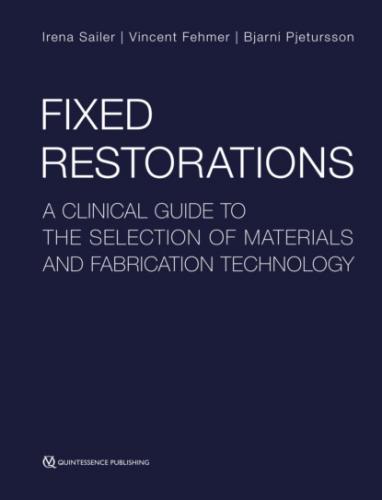Fixed Restorations. Irena Sailer
of material into the desired three-dimensional object, by means of a computer-controlled milling machine2. However, these procedures present several shortcomings such as waste of considerable amounts of material, impossibility to create geometries that lie below the milling bur diameter, or the impossibility to allow for mass production of components1,3. These restrictions can be overcome by the introduction of additive processing routes of layered fabrication5. An example of these technologies is three-dimensional (3D) printers, which allow the manufacturing of several objects at the same time in a precise and cost-efficient manner. The 3D printers work by jetting photopolymerizable materials in ultrathin layers. Each layer is cured by ultraviolet light immediately after it is deposited, producing fully cured objects6. The dual jetting printing procedure requires two materials: a hard fundament material and a gel-like support material. The support material is necessary to sustain complex geometries of the fundamental material during fabrication and it is easily removed by water jetting after printing. Micron-accurate shapes can be printed in different combinations of photopolymers, producing materials with specific mechanical and visual properties. Products with different levels of strength, rigidity, color, transparency, heat resistance, or texture can be obtained. This production modality has widened the indication spectrum of restorative computer-assisted dentistry. It may be assumed that dental restorations can be printed one day, mimicking all optical (and possibly mechanical) properties of natural teeth.
1.3.3 Optical factors influencing the material selection
The evaluation of the clinical site for the selection of the restorative material for a tooth- or implant-borne restoration encompasses the analysis of the translucency and the lightness/brightness of the neighboring reference teeth, together with the available restorative space and the degree of discoloration of the abutment tooth/teeth.
Translucency of the neighboring reference teeth
The first step in the systematic evaluation of the reference teeth for material selection is the assessment of light transmission in the reference teeth. The amount of translucency or opacity in the reference teeth has to be defined. The first assessment is therefore based on optical criteria of both the teeth and the ceramics (Fig 1-3-1; see also Chapter 2, Part I).
Fig 1-3-1a Highly translucent tooth 21 serves as reference to restore missing tooth 11.
Fig 1-3-1b Tooth 11 was restored with a glass-ceramic implant and crown.
Fig 1-3-1c Highly opaque tooth 11 serves as reference to restore missing tooth 21.
Fig 1-3-1d Tooth 21 was restored with a veneered zirconia crown.
If the teeth exhibit high translucency (high amount of light transmission; see Figs 1-3-1a and b), glass-ceramics shall be the preferred restorative material. It ensures a maximum of light flow and glass-ceramic crowns per se exhibit a translucent effect7–10. In the case of other core materials, this effect may be amplified by the use of translucent veneering ceramics.
In contrast, in case of a deeply opaque reference tooth (with low amount of light transmission), often a monochrome color effect is associated. Thus, zirconia may be recommended as core material due to its material properties, the uniform tooth-colored appearance, and adapted translucency9. By the use of highly translucent veneering ceramics in combination with opaque zirconia cores a predictable esthetic outcome may be achieved (Figs 1-3-1c and d). More recently, new zirconia types are available with increased translucencies and different shades. These more esthetic types of zirconia can be used without veneering ceramic (ie, monolithic), or with a buccal microveneering.
Brightness/value of the neighboring teeth
The second step in the evaluation of the material selection is the assessment of the brightness value of the reference teeth. Thus, the second assessment also focuses on visual criteria. Basically, the brightness value can be subdivided into the color “White,” the color with the highest brightness value, and into the color “Black,” the color with the lowest brightness value. By transferring this information to the clinical setting, the color “White” represents a very bright and opaque tooth. In contrast, the color “Black” is associated with a rather grayish, and translucent tooth (see Fig 1-3-2a).
Fig 1-3-2a Tooth 11 with a high value represents pronounced brightness and serves as reference to restore missing tooth 21.
Fig 1-3-2b Tooth 11 was restored with a veneered zirconia implant crown.
Fig 1-3-2c Tooth 11 with a medium value of brightness and a highly chromatic value serves as reference to restore missing tooth 21.
Fig 1-3-2d Tooth 21 was restored with a glass-ceramic implant crown.
Fig 1-3-2e Tooth 21 with a low value of brightness and a high amount of gray color serves as reference to restore missing tooth 11.
Fig 1-3-2f Tooth 11 was restored with a porcelain-fused-to-metal implant crown.
In case the framework material is selected based on the brightness value of the reference teeth, the most predictable result may be achieved, if “White” teeth are restored with zirconia crowns (Figs 1-3-2a and b) and “Black” teeth with increasing intensity of the gray and translucent appearance are restored with glass-ceramic (Figs 1-3-2c and d) or metal-ceramic crowns (Fig 1-3-2e and f).
Amount of space in the facial area
The third step in the evaluation is based on technical aspects and includes the assessment of the available buccal space. The available space is divided into “minimal” or “sufficient.” Considering the clinical and technical requirements of restoration materials such as the opacity level or the minimum wall thickness, the material of choice in minimal or less invasive areas (with an available space of ≤1 mm) is exclusively glass-ceramic. These ceramics (feldspathic or glass-ceramic) are the only materials that allow unimpeded light transmission to the supporting tooth surface (Figs 1-3-3a to f). If the available space is greater than 1.2 mm, zirconia may be a valuable alternative to glass-ceramics (Figs 1-3-3g to l). In clinical situations with an available space of ≥1.5 mm, the selection of the most appropriate framework material is less crucial (Figs 1-3-3m to o).
Fig 1-3-3a Initial situation of a
